| Do you need to develop an application based on OpenSwing?
The same team of developers that realized OpenSwing may develop it for you, using their high skills and in little time! |
OpenSwing is an open-source suite of advanced graphics components based on Swing toolkit: these components are more sophisticated of those provided with Swing and can be manipolated directly inside the UI designer of the IDE.
It is also a framework that provides data binding mechanism between components and data model, based on the MVC paradigm. Data model is based on Java Beans (POJOs) and it is supported in all OpenSwing components, such as grid control, tree control or generic controls container.
OpenSwing provides a complete solution (a framework and advanced swing components with data binding capabilities) to quickly and easily develop rich-client applications.
It is possibile to apply this framework to develop java Desktop Applications or Rich Internet Applications (three tiered applications based on Swing front-end + HTTP + java servlet + database) or Distributed Applications (three tiered applications based on Swing front-end + RMI + java session bean stateless + database).
OpenSwing includes a collection of classes that can be used:
|
|
Moreover, this framework provides some basic features that cover many issues that usually arise in enterprise application development, such as data extraction from grids and data import to grids, document viewing on the most popular desktop applications (like reports on Excel, CSV, XML, HTML, PDF, RTF), activities logging, internationalization support (label translation, date format, decimal symbols, grouping, currency support, etc.), authorization management according to grants owned by connected user.
All these framework components are strongly decoupled each other, by means of an accurate objects design, based on interface adoption that facilitate the implementation of new behaviours for base framework components.
It can be used with java 1.4, 1.5 or 1.6.
Openswing links
| OpenSwing has been awarded by JARS as TOP 1% RATED |  |
| OpenSwing has been awarded by FindMySoft.com |  |
See an article about OpenSwing published in Java Developer Journal.
See a sample application based on OpenSwing and JGoodies look 'n feel.
See JAllInOne beta preview (you must have JRE >= 1.4.2 installed on your machine); to authenticate into this application use the account: "guest" / "guest". This is an ERP application based on OpenSwing. See the screenshot below.

|
Use of Openswing in commercial products
OpenSwing is released with LGPL licence, i.e. you are free to use Openswing library into non-free programs and these can have another kind of licence (e.g. commercial license); in fact, LGPL licence distinguishes between a "work based on the library" and a "work that uses the library": the former contains code derived from the library, whereas the latter must be combined with the library in order to run. A "work based on the Library" inherits the same LGPL licence, but a "work that uses the library" not: if your application only uses Openswing then your application can have another licence.
Please report in this forum a brief description about applications based on OpenSwing you have realized!
| Do you need to develop an application based on OpenSwing?
The same team of developers that realized OpenSwing may develop it for you, using their high skills and in little time! |
| What's new 2011-03-03 Available update of OpenSwing manual 2013-07-06 OpenSwing release 2.4.7 is available. |
|
|
Past news |
|
 a Free Rapid Application Development tool to create web and mobile applications
a Free Rapid Application Development tool to create web and mobile applications |